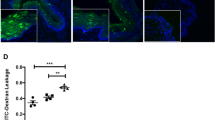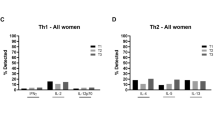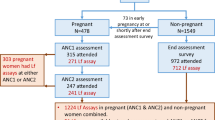Abstract
Objective:
To examine the relationship between selenium nutritional status and intermediates of human immunodeficiency virus (HIV)-1 transmission.
Design:
Prospective cohort study.
Setting:
A study clinic at Muhimbili National Hospital, Dar es Salaam, Tanzania.
Subjects:
A total of 340 HIV-1-infected pregnant women with gestational ages 12–27 weeks.
Methods:
Women's plasma selenium concentrations were determined at enrollment and modeled as tertiles (tertile 1: <114 μg/l (reference); tertile 2: 114–131 μg/l; tertile 3: >131 μg/l). Cervicovaginal lavage specimens were obtained at 36 weeks of gestation to determine HIV-1 RNA and interleukin-1β (IL-1β) levels. In subgroup analyses, 123 women with genital tract infections at enrollment were excluded.
Results:
Plasma selenium concentrations ⩾114 μg/l were related to increased risk of lower-genital shedding of HIV-1 RNA. Excluding women with genital tract infections strengthened the associations (relative risk (RR) tertile 2: 1.46, 95% confidence interval (CI)=1.10, 1.92; RR tertile 3: 1.39, 95% CI=1.05, 1.84). There was evidence for an association between plasma selenium concentrations ⩾114 μg/l and increased HIV-1 RNA levels among the entire cohort and after excluding women with genital tract infections. There was no association between plasma selenium and IL-1β concentrations.
Conclusions:
High selenium status may lead to increased risk of genital HIV-1 shedding, but data from other studies indicate that the evidence is mixed. Results from ongoing selenium trials are awaited to clarify the impact of selenium on HIV-1-related transmission endpoints.
Sponsorship:
National Institute of Child Health and Human Development (NICHD R01 32257) and the Fogarty International Center (NIH D43 TW00004).
This is a preview of subscription content, access via your institution
Access options
Subscribe to this journal
Receive 12 print issues and online access
$259.00 per year
only $21.58 per issue
Buy this article
- Purchase on Springer Link
- Instant access to full article PDF
Prices may be subject to local taxes which are calculated during checkout
Similar content being viewed by others
References
Baeten JM, Mostad SB, Hughes MP, Overbaugh J, Bankson DD, Mandaliya K et al. (2001). Selenium deficiency is associated with shedding of HIV-1-infected cells in the female genital tract. J Acquir Immune Defic Syndr 26, 360–364.
Burton GW, Ingold KU (1984). beta-Carotene: an unusual type of lipid antioxidant. Science 224, 569–573.
Deagan JT, Butler JA, Zachara A, Whanger PD (1993). Determination of the distribution of selenium between glutathione peroxidase, selenoprotein P, and albumin in plasma. Anal Biochem 208, 176–181.
Diamond AM, Hu YJ, Mansur DB (2001). Glutathione peroxidase and viral replication: implications for viral evolution and chemoprevention. Biofactors 14, 205–210.
Drain PK, Baeten JM, Overbaugh J, Wener MH, Bankson DD, Lavreys L et al. (2006). Low serum albumin and the acute phase response predict low serum selenium in HIV-1 infected women. BMC Infect Dis 6, 85.
Fawzi W, Msamanga G, Antelman G, Xu C, Hertzmark E, Spiegelman D et al. (2004a). Effect of prenatal vitamin supplementation on lower-genital levels of HIV type 1 and interleukin type 1 beta at 36 weeks of gestation. Clin Infect Dis 38, 716–722.
Fawzi WW, Msamanga G, Hunter D, Urassa E, Renjifo B, Mwakagile D et al. (2000). A randomized trial of vitamin supplements in relation to vertical transmission of HIV-1 in Tanzania. J Acquir Immune Def Syndr 23, 246–254.
Fawzi WW, Msamanga GI, Spiegelman D, Urassa EJ, McGrath N, Mwakagile D et al. (1998). Randomised trial of effects of vitamin supplements on pregnancy outcomes and T cell counts in HIV-1-infected women in Tanzania. Lancet 351, 1477–1482.
Fawzi WW, Msamanga GI, Spiegelman D, Wei R, Kapiga S, Villamor E et al. (2004b). A randomized trial of multivitamin supplements and HIV disease progression and mortality. N Engl J Med 351, 23–32.
Feldman JG, Burns DN, Gange SJ, Bacchetti P, Cohen M, Anastos K et al. (2000). Serum albumin as a predictor of survival in HIV-infected women in the Women's Interagency HIV study. AIDS 14, 863–870.
Feldman JG, Gange SJ, Bacchetti P, Cohen M, Young M, Squires KE et al. (2003). Serum albumin is a powerful predictor of survival among HIV-1-infected women. J Acquir Immune Defic Syndr 33, 66–73.
Fichorova RN, Tucker LD, Anderson DJ (2001). The molecular basis of nonoxynol-9-induced vaginal inflammation and its possible relevance to human immunodeficiency virus type 1 transmission. J Infect Dis 184, 418–428.
Kitano K, Baldwin GC, Raines MA, Golde DW (1990). Differentiating agents facilitate infection of myeloid leukemia cell lines by monocytotropic HIV-1 strains. Blood 76, 1980–1988.
Kupka R, Garland M, Msamanga G, Spiegelman D, Hunter D, Fawzi W (2005). Selenium status, pregnancy outcomes, and mother-to-child transmission of HIV-1. J Acquir Immune Defic Syndr 39, 203–210.
MacDonald KS, Malonza I, Chen DK, Nagelkerke NJ, Nasio JM, Ndinya-Achola J et al. (2001). Vitamin A and risk of HIV-1 seroconversion among Kenyan men with genital ulcers. AIDS 15, 635–639.
Mason M, Morris J, Spate V, Baskett C, Nichols T, Horsman T et al. (1998). Comparison of whole blood, plasma, and nails as monitors for the dietary intake of selenium. J Radioanal Nucl Chem 236, 29–34.
McClelland RS, Baeten JM, Overbaugh J, Richardson BA, Mandaliya K, Emery S et al. (2004). Micronutrient supplementation increases genital tract shedding of HIV-1 in women: results of a randomized trial. J Acquir Immune Defic Syndr 37, 1657–1663.
Miettinen O (1985). Theoretical Epidemiology. John Wiley & Sons: New York.
Montano M, Russell M, Gilbert P, Thior I, Lockman S, Shapiro R et al. (2003). Comparative prediction of perinatal human immunodeficiency virus type 1 transmission, using multiple virus load markers. J Infect Dis 188, 406–413.
Mostad SB, Overbaugh J, DeVange DM, Welch MJ, Chohan B, Mandaliya K et al. (1997). Hormonal contraception, vitamin A deficiency, and other risk factors for shedding of HIV-1 infected cells from the cervix and vagina. Lancet 350, 922–927.
Neve J (2000). New approaches to assess selenium status and requirement. Nutr Rev 58, 363–369.
Pace GW, Leaf CD (1995). The role of oxidative stress in HIV disease. Free Radic Biol Med 19, 523–528.
Rayman MP (2002). The argument for increasing selenium intake. Proc Nutr Soc 61, 203–215.
Tuomala RE, O'Driscoll PT, Bremer JW, Jennings C, Xu C, Read JS et al. (2003). Cell-associated genital tract virus and vertical transmission of human immunodeficiency virus type 1 in antiretroviral-experienced women. J Infect Dis 187, 375–384.
Turpin JA, Vargo M, Meltzer MS (1992). Enhanced HIV-1 replication in retinoid-treated monocytes. Retinoid effects mediated through mechanisms related to cell differentiation and to a direct transcriptional action on viral gene expression. J Immunol 148, 2539–2546.
UNAIDS (2005). AIDS Epidemic Update. UNAIDS: Geneva, Switzerland.
Wang CC, McClelland RS, Overbaugh J, Reilly M, Panteleeff DD, Mandaliya K et al. (2004). The effect of hormonal contraception on genital tract shedding of HIV-1. AIDS 18, 205–209.
Acknowledgements
This work was supported by the National Institute of Child Health and Human Development (NICHD R01 32257) and the Fogarty International Center (NIH D43 TW00004).
Author information
Authors and Affiliations
Corresponding author
Additional information
Guarantor: R Kupka.
Contributors: GIM, DH and WWF contributed to the study design. CX and DA performed the laboratory analyses for CVL samples. RK carried out the data analyses, interpreted the results and wrote the initial draft of the manuscript. All authors participated in data interpretation and contributed to the final version of the manuscript. WWF and GIM are principal investigators of the study.
Rights and permissions
About this article
Cite this article
Kupka, R., Msamanga, G., Xu, C. et al. Relationship between plasma selenium concentrations and lower genital tract levels of HIV-1 RNA and interleukin type 1β. Eur J Clin Nutr 61, 542–547 (2007). https://doi.org/10.1038/sj.ejcn.1602567
Received:
Revised:
Accepted:
Published:
Issue Date:
DOI: https://doi.org/10.1038/sj.ejcn.1602567
Keywords
This article is cited by
-
Determinants of HIV shedding in the lower genital tract of women
Current Infectious Disease Reports (2008)



